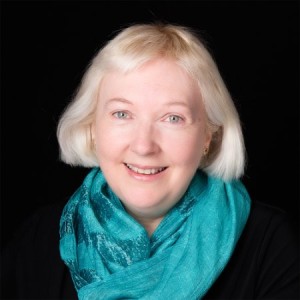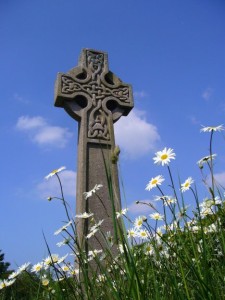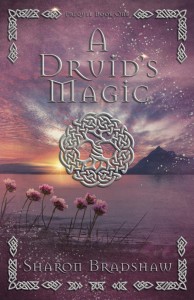Did some Druids survive the Romans’ attack c. 60-61AD? History is written by the victors, and my blog guest this week, historical fiction author Sharon Bradshaw, challenges certain “facts” people accept about history in the British Isles.
~~~
 Relevant History welcomes Sharon Bradshaw, a historical fiction author, storyteller, and poet. Sharon loves reading archaeology books and talked to a lot of monks in the 8th century while writing the Durstan series. A Druid’s Magic is set in the real Middle-Earth we called the Dark Ages. Subscribers to The Storyteller’s Newsletter receive a free short story from her every month. Sharon lives with her family and a large collection of books near Warwick Castle, in the UK. To learn more about her and her books, visit her web site, and follow her on Facebook and Twitter.
Relevant History welcomes Sharon Bradshaw, a historical fiction author, storyteller, and poet. Sharon loves reading archaeology books and talked to a lot of monks in the 8th century while writing the Durstan series. A Druid’s Magic is set in the real Middle-Earth we called the Dark Ages. Subscribers to The Storyteller’s Newsletter receive a free short story from her every month. Sharon lives with her family and a large collection of books near Warwick Castle, in the UK. To learn more about her and her books, visit her web site, and follow her on Facebook and Twitter.
*****
I write the Durstan series about a young monk in 794AD on the Hebridean island of Iona. The early Medieval period (500AD–1000AD), which I had been taught at school to call the “Dark Ages,” wasn’t dark at all. It was a rich and magical place where spellcasting and superstition were rife. A pantheon of old gods existed from the Iron Age, and before.
 People believed in the existence of elves, faeries, and dragons in a way that was not so far removed from J.R.R Tolkien’s Middle-earth. All of this was reflected in Anglo-Saxon and Celtic art, jewelry, and weapons; ancient place names; and a belief in destiny woven through the threads of the Wyrd. The monks themselves were regarded as spellcasters. The letters they wrote were similar to the marks made by a Druid’s runes.
People believed in the existence of elves, faeries, and dragons in a way that was not so far removed from J.R.R Tolkien’s Middle-earth. All of this was reflected in Anglo-Saxon and Celtic art, jewelry, and weapons; ancient place names; and a belief in destiny woven through the threads of the Wyrd. The monks themselves were regarded as spellcasters. The letters they wrote were similar to the marks made by a Druid’s runes.
.
Monasteries and the early Church
I was also taught that everyone converted to Christianity as soon as it arrived in the British Isles. Yet the further I delved into the past, the more it became clear. Christianity had stood for centuries side-by-side with belief in the ancestors’ gods. The Synod of Whitby in 664AD highlighted the depth to which diversity in belief ran at that time. Not only was there a pantheon of gods, all of which was not necessarily followed by every individual, but differences existed within the Church itself. Easter was celebrated on separate dates by Celtic and Roman rival followings, and a monk’s tonsure was cut in a way which depended on whether he followed St. John or St. Peter.
Despite the 4th-century Benedictine rule being recognised by the Iona monastery, Lindisfarne, and others, the rule wasn’t strictly observed until after the Norman Conquest. Until then, an abbot could run a monastery however he chose. Monks married and fathered children, ignoring the vow of chastity, while monks and nuns could live together as they did in Whitby. If that wasn’t enough, the Vikings brought their own gods with them when they raided Lindisfarne in 793AD and later settled in the British Isles.
What happened on Anglesey?
 Many believe that all the Druids were massacred by the Romans during the Boudican revolt c. 60-61AD. Druids in Gaul had been obliterated earlier, and historians relied for centuries on a sparse account by Tacitus (56–120AD) of what happened on the island of Anglesey. He didn’t write from personal experience, and his work is no longer regarded as impartial. Sadly the Druids didn’t leave behind an alternate version of events for us to read. Nor did they use a form of writing which would have enabled them to do so.
Many believe that all the Druids were massacred by the Romans during the Boudican revolt c. 60-61AD. Druids in Gaul had been obliterated earlier, and historians relied for centuries on a sparse account by Tacitus (56–120AD) of what happened on the island of Anglesey. He didn’t write from personal experience, and his work is no longer regarded as impartial. Sadly the Druids didn’t leave behind an alternate version of events for us to read. Nor did they use a form of writing which would have enabled them to do so.
Celtic Ireland
A number of Druids fled from the Romans during the first century AD to seek refuge in Celtic Ireland, which remained free from occupation. They played an important part in its mythology and became counselors to kings and respected prophets. Early Irish law confirms their decline as Christianity spread, but these men were still regarded highly in the 6th century when they taught the Aethelings. It’s possible that they traveled again through the British Isles, in particular after the Romans left in 410.
We know that some of their order joined the Church. Adomnan, Abbot of Iona (628–724AD) and biographer of St. Columba (521–597AD), attributes the saint with many qualities of a shaman: weather magic, miracles, second sight, and angelic apparitions. St. Columba came from a Druidic background in Ireland. Other saints were similarly attributed with these magical qualities, which remained an important part of the belief system in Anglo-Saxon Middle Earth.
The Druid bards
The bards told their stories when there was a feast. Beowulf and fragments in the 10th-century Exeter Book are thought to be examples of earlier tales from the 7th-century mead halls. A warlord who had yet to convert to Christianity would have welcomed the man or woman who could read the stars better than himself and converse with the gods. Even better if there was a tale or two to be told.
Despite no longer being leaders of Celtic society in the early Medieval period, the descendants of the Druid bards kept traditional beliefs alive in their tales of the past, while belief in the gods and goddesses of old survives today. You’ll find it in our long history of storytelling, folklore, and legend.
*****
 A big thanks to Sharon Bradshaw! She’ll give away one ebook copy of A Druid’s Magic to a reader in the UK who contributes a comment on my blog as well as one ebook copy to a reader in the United States who contributes a comment. I’ll choose the two winners from among those who comment by Tuesday at 6 p.m. ET.
A big thanks to Sharon Bradshaw! She’ll give away one ebook copy of A Druid’s Magic to a reader in the UK who contributes a comment on my blog as well as one ebook copy to a reader in the United States who contributes a comment. I’ll choose the two winners from among those who comment by Tuesday at 6 p.m. ET.
**********
Did you like what you read? Learn about downloads, discounts, and special offers from Relevant History authors and Suzanne Adair. Subscribe to Suzanne’s free newsletter.

Excellent and informative post so signing up to Suzanne’s website. Having discovered Tolkien in my teens through his academic writing, I always saw that his Middle-Earth owed so much to this ‘dark age’ period and was one of the ‘lost bardic tales’ like Beowulf. [Note: I’m a Brit ex-pat living in the US.]
Hi Roland, thank you for your comment. I am pleased that you enjoyed the post, and are also a fan of the “Dark Ages.” I can imagine Tolkien, sitting in his study at Oxford university in 1925, as professor of Anglo Saxon. The manuscripts he must have read from the early Medieval period, as part of his academic work, then beginning to create a version of Middle-Earth from what he had discovered. I agree, with you. You can see the influence of early Germanic and Old English literature in his books, the poetry, and mythology. It’s wonderful that we are able now to view the Dark Ages in this different light. A rich, and in many ways, sophisticated culture going back to the Iron Age and most probably before.
My childhood memories are of many superstitions and customs to do with respect for the little folk – this was in Mid-Wales. We children never questioned the matter when told not to go to a certain place at a certain time – folk memories of ancient rituals, perhaps. And there were lots of fireside tales of magical events from long ago. I heartily agree that the so-called Dark Ages was a period of rich culture and innovation.
Hi Beth, thank you for your comment. What lovely memories to have of your childhood! Traditional tales often have an underlying message, or warning to pass onto the listener. We may think of them now as superstition, but they would have had an important meaning for someone during their history. The Mabinogion written in the 13th century created an image of an enchanted world with its roots firmly fixed in the hills, valleys, and forests of Ancient Wales. The stories in this book may well have been told in the mead halls long before that. It’s wonderful to hear of tradition and folk memory still being passed on, as they were to you.
Beth Elliott, back in 1982, I was driving through the mountains of Gwynedd and, in a beautiful wooded area, pulled over to let a lorry pass. Got out of the car to stretch my legs and gazed at a small meadow where a few sheep were grazing. In the middle of the meadow was a menhir, perhaps 7 feet tall. Assorted freshly-cut flowers had been strewn at the base of the menhir. It was my first exposure to “respect for the little folk” or whatever else the menhir signified to the locals.
That was a very interesting experience. One thing my Welsh grannie insisted on was always to crush eggshells, so the little folk couldn’t use them for boats. I still do it.
I haven’t heard of that, Beth, but what a lovely tradition. There are a number of old tales which warn of the consequences of eating faerie food, and the harm which may befall you if you do. Perhaps that was the origin of Christina Rossetti’s, Goblin Market? A wonderful, story poem. Did your Welsh Grannie tell you what might happen if the little folk had their boats? Was it unlucky, if they sailed away?
Thanks so much for this enlightening article. I’ve read a bit about the time period and have been fascinated by how so many beliefs have survived the centuries. Will definitely sign up for Sharon’s blog.
Thank you, Michelle. You are very welcome. I send my free newsletter out once a month, with a short story, and some history included. If I’m launching a book, I write extra newsletters, so that I can talk specifically about the history behind the book and the research I did. Unfortunately you have just missed the launch of the prequel and 1st novel in the Durstan series, but if you would like to learn more and sign up via my website, the last newsletter is scheduled for tomorrow at 16.00GMT. It’s about the Vikings and there’s a chapter from The Monk Who Cast a Spell to read. Erik the Viking warlord is one of the main characters in the series. https://www.sharonbradshaw.com/ It’d be great to keep in touch. Thank you for your comment.
Viking? Did someone say Viking? I’ve been lapping up Viking/Norse lore for decades and can’t get enough. Even wrote an alternative Viking Age tale.
That sounds fascinating, Roland. I am looking forward to hearing more. Yes, my newsletter tomorrow at 16.00GMT, is dedicated to the Vikings in 794AD. Thank you, for subscribing. You should by now have received a welcome email and story, then tomorrow afternoon you’ll get the one about the Vikings! If you want to read any of the others in the launch, talking more about the history behind the Durstan series and with extracts from the books, please message me and I’ll send them to you. Enjoy!
I found this fascinating. Being brought up in the U.S. not much taught about wee folk and the magic of the past,however as a reader I have enjoyed such talk. I like Stephan Lawhead’s books and Tolekin. Will sign up for your newsletter and learn more.
Thank you, Candy. I’m pleased that you enjoyed the post. We are fortunate in the UK to have such a long history of storytelling, tradition, and folklore which has survived until today. Warwick where I live near the castle has a folk festival every year. The Morris Men dance in the streets of the town, all weekend. There are folk songs, a mummers’ play, and lots more. It’s not to be missed, while the fae are with us all the time. We have lots of stories about their world, and Suzanne’s menhir may well have been worshipped for millenia. Many of them were thought to be sacred places where you would find the Ancestors’ Gods, or a God of place. I’m pleased that you want to keep in touch, and thank you for saying that you’ll sign up for the newsletter. Please click the link below, and go to the newsletter page for more information. I have one coming out tomorrow at 16.00GMT about the Vikings. There’ll also be a chapter from my novel, The Monk Who cast a Spell, to read. https://www.sharonbradshaw.com/
In addition to Beth’s comment about crushing eggshells, I was brought up in Scotland and my naval father made sure that each of us 4 children always put the spoon through the bottom of the shell ‘to stop the witches going to sea and drowning sailors’. We tended to make quite large holes and cursed the witches! Fascinating article, thank you.
You are welcome, Charlotte. Thank you for your comment, and reminding me of this. My Father used to say that it was to let the bad faery out, but witch or faery, it’s a wonderful tradition! I wish I could tell you its origin. Sadly, I didn’t find out.